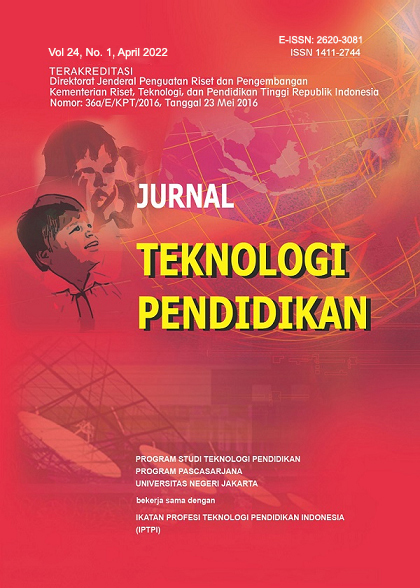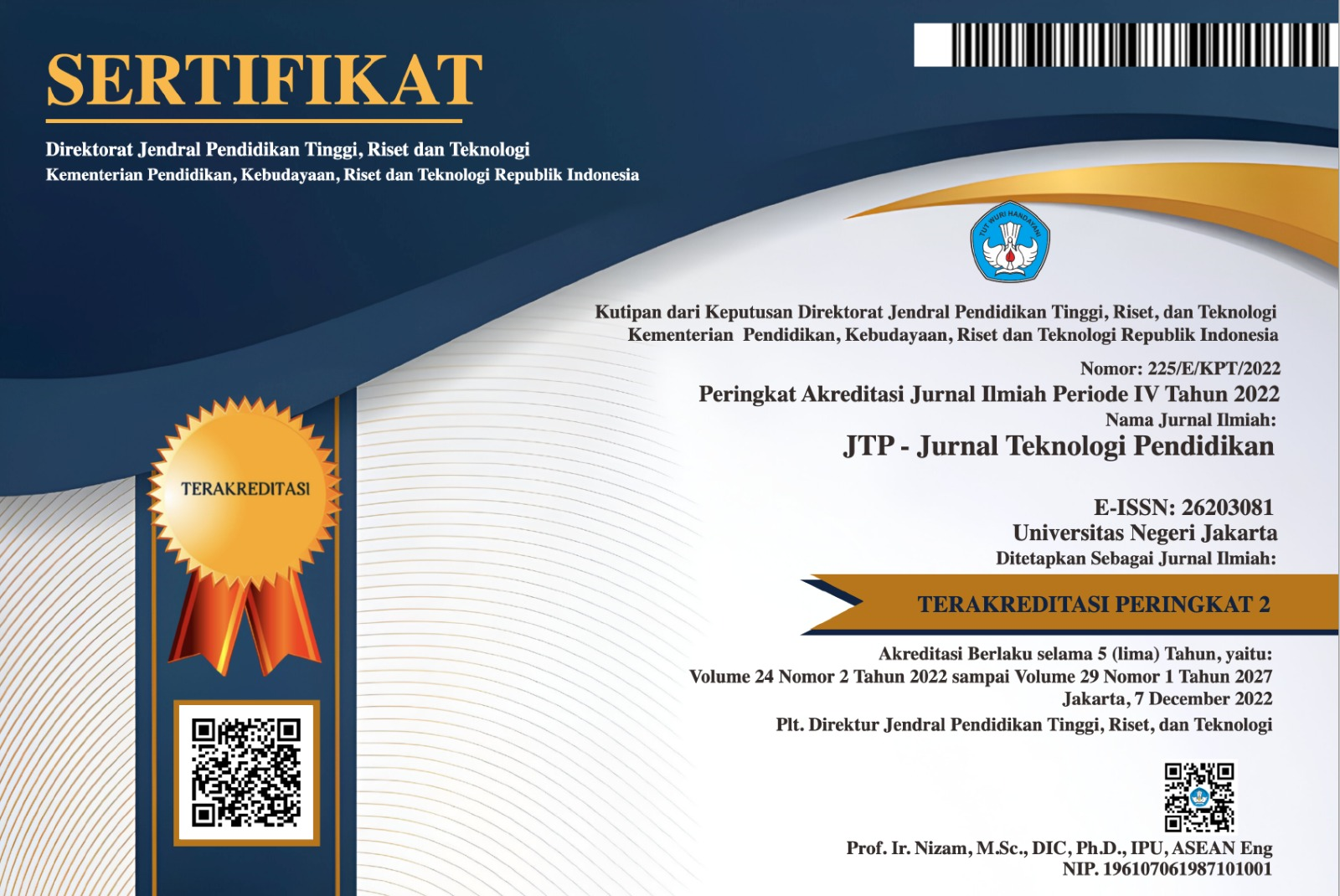Developing Augmented Reality (AR) as Assisted Technology in Reading Based on Content-Language Integrated Learning
DOI:
https://doi.org/10.21009/jtp.v24i1.23626Keywords:
Developing Material, Augmented Reality, Reading, EFL LearnersAbstract
Assisted technology has become one of the primary needs for inclusive education, especially for language learning. Language learning mediated by technology can provide affordances to EFL learners with low English language skills. Therefore, an assisted technology with content-language integrated learning was developed with the ADDIE approach to producing meaningful and motivational language learning with a dual focus, namely content and language. The materials presented in the assisted technology were developed stick to the Line-of-Sight by the Branch model (2009), which covers needs, goals, strategies, and assessment. The technology and material development result were named assisted technology-enhanced language learning (ATELL) and created with a marker-based augmented reality application. The AR application is an assisted technology for reading comprehension skills that guide the students in critical thinking for critical reading activities. The findings of the study show that students who read with the AR application performed better than those who read with the traditional method. The students also reported that they have a positive perception of the integration of the AR application for language learning for several attributes such as technology interactivity, compatibility, learning ambience, and cognitive condition.
References
Aldoobie, N. (2015). ADDIE Model. American International Journal of Contemporary Research, 5(6), 68–72.
Bonner, E., & Reinders, H. (2018). Augmented and Virtual Reality in the Language Classroom: Practical Ideas. Teaching English with Technology, 18(3), 33–53. http://www.tewtjournal.org
Branch, R. M. (2009). Instructional Design: The ADDIE Approach. Springer.
Buchner, J., Buntins, K., & Kerres, M. (2021). A systematic map of research characteristics in studies on augmented reality and cognitive load. Computers and Education Open, 2(November 2020), 100036. https://doi.org/10.1016/j.caeo.2021.100036
Bujak, K. R., Radu, I., Catrambone, R., MacIntyre, B., Zheng, R., & Golubski, G. (2013). A psychological perspective on augmented reality in the mathematics classroom. Computers and Education, 68, 536–544. https://doi.org/10.1016/j.compedu.2013.02.017
Bursali, H., & Yilmaz, R. M. (2019). Effect of augmented reality applications on secondary school students’ reading comprehension and learning permanency. Computers in Human Behavior, 95(June 2018), 126–135. https://doi.org/10.1016/j.chb.2019.01.035
Cabero-Almenara, J., Fernández-Batanero, J. M., & Barroso-Osuna, J. (2019). Adoption of augmented reality technology by university students. Heliyon, 5(5), e01597. https://doi.org/10.1016/J.HELIYON.2019.E01597
Chen, M., Wang, L., Zou, D., Lin, S., Xie, H., Wang, L., Zou, D., Lin, S., Xie, H., Chen, M., Wang, L., & Zou, D. (2020). Effects of captions and English proficiency on learning effectiveness , motivation and attitude in augmented-reality-enhanced theme-based contextualized EFL learning. Computer Assisted Language Learning, 0(0), 1–31. https://doi.org/10.1080/09588221.2019.1704787
Doiz, A., Lasagabaster, D., & Sierra, J. M. (2014). CLIL and motivation: the effect of individual and contextual variables. Https://Doi.Org/10.1080/09571736.2014.889508, 42(2), 209–224. https://doi.org/10.1080/09571736.2014.889508
Flores-Gallegos, R., Rodríguez-Leis, P., & Fernández, T. (2021). Effects of a virtual reality training program on visual attention and motor performance in children with reading learning disability. International Journal of Child-Computer Interaction, 100394. https://doi.org/10.1016/J.IJCCI.2021.100394
Garzón, J., & Acevedo, J. (2019). Meta-analysis of the impact of Augmented Reality on students’ learning gains. Educational Research Review, 27(April), 244–260. https://doi.org/10.1016/j.edurev.2019.04.001
Guan, N., Song, J., & Li, D. (2018). On the advantages of computer multimedia-aided English teaching. Procedia Computer Science, 131, 727–732. https://doi.org/10.1016/j.procs.2018.04.317
Halpern, D. F. (2001). Critical Thinking, Cognitive Psychology of. In N. J. Smelser & P. B. Baltes (Eds.), International Encyclopedia of the Social & Behavioral Sciences (pp. 2990–2994). https://doi.org/10.1016/b0-08-043076-7/01586-2
Howorth, S. K., Rooks-Ellis, D., Flanagan, S., & Ok, M. W. (2019). Augmented Reality Supporting Reading Skills of Students with Autism Spectrum Disorder: Https://Doi.Org/10.1177/1053451219837635, 55(2), 71–77. https://doi.org/10.1177/1053451219837635
Huang, X., Zou, D., Cheng, G., Xie, H., & Kim, M. J. (2021). sustainability A Systematic Review of AR and VR Enhanced Language Learning. https://doi.org/10.3390/su13094639
Ismail, M. E., Utami, P., Ismail, I. M., Khairudin, M., Amiruddin, M. H., Lastariwati, B., & Maneetien, N. (2018). The Effect of an Augmented Reality Teaching Kit on Visualization, Cognitive Load and Teaching Styles. Jurnal Pendidikan Teknologi Dan Kejuruan, 24(2), 178–184. https://doi.org/10.21831/jptk.v24i2.20031
Karacan, C. G., & Akoğlu, K. (2021). Educational Augmented Reality Technology for Language Learning and Teaching: A Comprehensive Review. Shanlax International Journal of Education, 9(2), 68–79. https://doi.org/10.34293/education.v9i2.3715
Kaur, D. P., Mantri, A., & Horan, B. (2020). Enhancing Student Motivation with use of Augmented Reality for Interactive Learning in Engineering Education. Procedia Computer Science, 172, 881–885. https://doi.org/10.1016/J.PROCS.2020.05.127
Kesim, M., & Ozarslan, Y. (2012). Augmented Reality in Education: Current Technologies and the Potential for Education. Procedia - Social and Behavioral Sciences, 47(222), 297–302. https://doi.org/10.1016/j.sbspro.2012.06.654
Kipper, G. (2013). What Is Augmented Reality? Augmented Reality, 1–27. https://doi.org/10.1016/B978-1-59-749733-6.00001-2
Liono, R. A., Amanda, N., Pratiwi, A., & Gunawan, A. A. S. (2021). A Systematic Literature Review: Learning with Visual by The Help of Augmented Reality Helps Students Learn Better. Procedia Computer Science, 179, 144–152. https://doi.org/10.1016/J.PROCS.2020.12.019
Mayer, R. E., & Moreno, R. (2003). Nine ways to reduce cognitive load in multimedia learning. Educational Psychologist, 38(1), 43–52. https://doi.org/10.1207/S15326985EP3801_6
Parmaxi, A., & Demetriou, A. A. (2020). Augmented reality in language learning: A state-of-the-art review of 2014–2019. Journal of Computer Assisted Learning, 36(6), 861–875. https://doi.org/10.1111/jcal.12486
Rajkumar, R. (2019). Slow learners in English language classroom : Importance of technology and innovative strategies. August.
Riddell, S., & Weedon, E. (2013). Disabled students in higher education: Discourses of disability and the negotiation of identity. International Journal of Educational Research, 63, 38–46. https://doi.org/10.1016/j.ijer.2013.02.008
Sampaio, D., & Almeida, P. (2016). Pedagogical Strategies for the Integration of Augmented Reality in ICT Teaching and Learning Processes. Procedia Computer Science, 100, 894–899. https://doi.org/10.1016/j.procs.2016.09.240
Tzoannopoulou, M. (2015). Rethinking ESP: Integrating Content and Language in the University Classroom. Procedia - Social and Behavioral Sciences, 173, 149–153. https://doi.org/10.1016/j.sbspro.2015.02.045
Unin, N., & Bearing, P. (2016). Brainstorming as a Way to Approach Student-centered Learning in the ESL Classroom. Procedia - Social and Behavioral Sciences, 224, 605–612. https://doi.org/10.1016/J.SBSPRO.2016.05.450
Wilson, K. (2016). Critical reading , critical thinking : Delicate scaffolding in English for Academic Purposes ( EAP ). Thinking Skills and Creativity, 22, 256–265. https://doi.org/10.1016/j.tsc.2016.10.002
Yulian, R. (2021). The flipped classroom: Improving critical thinking for critical reading of EFL learners in higher education. Studies in English Language and Education, 8(2), 508–522. https://doi.org/10.24815/siele.v8i2.18366
Downloads
Published
How to Cite
Issue
Section
License
Jurnal Teknologi Pendidikan is an Open Access Journal. The authors who publish the manuscript in Jurnal Teknologi Pendidikan agree to the following terms.
Attribution-ShareAlike 4.0 International (CC BY-SA 4.0)
-
Attribution — You must give appropriate credit, provide a link to the license, and indicate if changes were made. You may do so in any reasonable manner, but not in any way that suggests the licensor endorses you or your use.
-
ShareAlike — If you remix, transform, or build upon the material, you must distribute your contributions under the same license as the original.
- No additional restrictions — You may not apply legal terms or technological measures that legally restrict others from doing anything the license permits.
Notices:
- You do not have to comply with the license for elements of the material in the public domain or where your use is permitted by an applicable exception or limitation.
- No warranties are given. The license may not give you all of the permissions necessary for your intended use. For example, other rights such as publicity, privacy, or moral rights may limit how you use the material.








